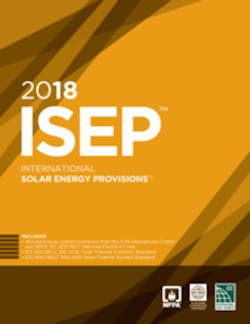As the demand for solar energy systems increases, so does the complexity of installing them properly. It’s an intricate process that touches and affects many different parts of a building – from roofing to electrical to plumbing.
“We’re looking for ways to streamline codes for solar energy. There’s a big push on many jurisdictions to implement solar, which is great. What we were hearing a lot of is, ‘It’s kind of hard to find [all of the proper codes].’” - Shawn Martin
In the past, code officials have had the burden of searching through numerous code books to find all of the right information regarding solar energy. They might need to see the International Building Code for one piece of information, then the International Mechanical Code for another.
“We’re looking for ways to streamline codes for solar energy,” says Shawn Martin, vice president of technical services for the International Code Council (ICC). “There’s a big push on many jurisdictions to implement solar, which is great. What we were hearing a lot of is, ‘It’s kind of hard to find [all of the proper codes].’”
As a facilities manager, investing in this one-stop resource will help ensure you’re complying with these codes – and in the process creating a safer and healthier building.
2018 International Solar Energy Provisions (ISEP)
1. 2018 International Building Code (IBC)
2. 2018 International Residential Code (IRC)
3. 2018 International Fire Code (IFC)
4. 2017 NFPA 70 National Electrical Code
5. 2018 International Fuel Gas Code (IFGC)
6. 2018 International Mechanical Code (IMC)
7. 2018 International Plumbing Code (IPC)
8. 2018 International Energy Conservation Code (IECC)
9. 2018 International Swimming Pool and Spa Code (ISPSC)
10. 2018 International Property Maintenance Code (IPMC)
11. 2018 International Wildland and Urban Interface Code (IWUIC)
“A lot of code officials have been thrilled, because instead of having to lug eight code books to a job site, they can bring the one and know that they have everything,” Martin says, adding that installers and manufacturers have also given positive feedback.
*BUILDINGS is a member of the Amazon Services LLC Associates Program and receives a small commission from each sale of this book from our site.
The 2018 update includes provisions for both commercial and residential buildings and for the design, installation and administration of both solar thermal and photovoltaic systems.
“We’re just thrilled with their partnership on this and are glad we can bring a comprehensive solution to the market,” Martin says.
Related: 10 Tips for Green Building Certification
He adds that the ICC considered creating a completely separate solar code. “Some organizations have taken that route, but we didn’t really feel comfortable with that because where does that stop? Then do we do a separate window code, a basement code? We struggled with that. We liked having [a solar code] in context within other codes. That seemed like the way to do it.”
Other Important Solar Energy Code Updates
One of the most important updates, explains Martin, addresses roof setbacks and pathways. That refers to creating pathways, lanes and areas on the roof where firefighters and first responders can walk safely during emergencies to ensure the safety of the inhabitants or tenants.
“A lot of code officials have been thrilled, because instead of having to lug eight code books to a job site, they can bring the one and know that they have everything,” - Shawn Martin
Another update includes important information on quick disconnects so that there is a consistent way to effectively shut down the solar power system if need be.
“There were a lot of efforts between firefighters and the solar industry to find a happy medium between trying to get as much solar production as we can without endangering the occupants or firefighters,” Martin says.
Additionally, the 2018 version addresses energy storage and battery systems, which Martin says are becoming a critical part of photovoltaic installations.
“We just simply excerpted and dropped [codes] in,” Martin says of creating the ISEP. “We tried to organize it in a way that’s logical. You can be reading along and you might be reading material from the Building Code and then it might switch to the Mechanical Code. We gave it its own numbering system, but in each case we note where it came from.”
7 Most Essential NFPA® Standards for Building Owners
Watch it on demand and learn about the following NFPA codes:
- NFPA 101®, Life Safety Code®
- NFPA 25, Standard for the Inspection, Testing, and Maintenance of Water-Based Fire Protection Systems
- NFPA 72®, National Fire Alarm and Signaling Code®
- NFPA 80, Standard for Fire Doors and Other Opening Protectives
- NFPA 3000TM (PS), Standard for an Active Shooter/Hostile Event Response (ASHER) Program
- NFPA 4, Standard for Integrated Fire Protection and Life Safety System Testing
- NFPA 70E®, Standard for Electrical Safety in the Workplace®
How to Get the New Solar Energy Document
The ISEP is available in two forms. The basic version, available for purchase online, includes the codes and a few basic resources (such as a checklist and a submittal requirements template for expedited permitting of photovoltaic systems).
The commentary version (coming soon) includes everything in the basic version but adds commentary and figures explaining the application of the various sections of code.
Two handpicked articles to read next:
About the Author

Sarah Kloepple
Associate Editor
Sarah joined the BUILDINGS team as an associate editor in August 2018. She is a graduate of the Missouri School of Journalism, where her focus was magazine writing. She's written and edited for numerous publications in her hometown of St. Louis.
